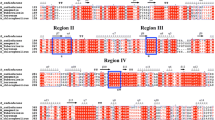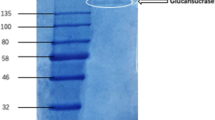Abstract
The trehalosyl dextrin-forming enzyme (TDFE) mainly catalyzes an intramolecular transglycosyl reaction to form trehalosyl dextrins from dextrins by converting the α-1,4-glucosidic linkage at the reducing end to an α-1,1-glucosidic linkage. In this study, the treY gene encoding TDFE was PCR cloned from the genomic DNA of Sulfolobus solfataricus ATCC 35092 to an expression vector with a T7 lac promoter and then expressed in Escherichia coli. The recombinant TDFE was purified sequentially by using heat treatment, ultrafiltration, and gel filtration. The obtained recombinant TDFE showed an apparent optimal pH of 5 and an optimal temperature of 75°C. The enzyme was stable in a pH range of 4.5–11, and the activity remained unchanged after a 2-h incubation at 80°C. The transglycosylation activity of TDFE was higher when using maltoheptaose as substrate than maltooligosaccharides with a low degree of polymerization (DP). However, the hydrolysis activity of TDFE became stronger when low DP maltooligosaccharides, such as maltotriose, were used as substrate. The ratios of hydrolysis activity to transglycosylation activity were in the range of 0.2–14% and increased when the DP of substrate decreased. The recombinant TDFE was found to exhibit different substrate specificity, such as its preferred substrates for the transglycosylation reaction and the ratio of hydrolysis to transglycosylation of the enzyme reacting with maltotriose, when compared with other natural or recombinant TDFEs from Sulfolobus.






Similar content being viewed by others
References
Bradford MM (1976) A rapid and sensitive method for the quantitation of microgram quantities of protein, utilizing the principle of protein-dye binding. Anal Biochem 72:248–254
Di Lernia I, Morana A, Ottombrino A, Fusco S, Rossi M, De Rosa M (1998) Enzymes from Sulfolobus shibatae for the production of trehalose and glucose from starch. Extremophiles 2:409–416
Fang TY, Coutinho PM, Reilly PJ, Ford C (1998a) Mutations to alter Aspergillus awamori glucoamylase selectivity. I. Tyr48Phe49→Trp, Tyr116→Trp, Tyr175→Phe, Arg241→Lys, Ser411→Ala and Ser411→Gly. Protein Eng 11:119–126
Fang TY, Honzatko RB, Reilly PJ, Ford C (1998b) Mutations to alter Aspergillus awamori glucoamylase selectivity. II. Mutation of residues 119 and 121. Protein Eng 11:127–133
Ford C (1999) Improving operating performance of glucoamylase by mutagenesis. Curr Opin Biotechnol 10:353–357
Gueguen Y, Rolland JL, Schroeck S, Flament D, Defretin S, Saniez MH, Dietrich J (2001) Characterization of the maltooligosyl trehalose synthase from the thermophilic archaeon Sulfolobus acidocaldarius. FEMS Microbiol Lett 194:201–206
Kato M (1999) Trehalose production with a new enzymatic system from Sulfolobus solfataricus KM1. J Mol Catalysis B Enzymatic 6:223–233
Kato M, Miura Y, Kettoku M, Komeda T, Iwamatsu A, Kobayashi K (1996a) Reaction mechanism of a new glycosyltrehalose-hydrolyzing enzyme isolated from the hyperthermophilic archaeum, Sulfolobus solfataricus KM1. Biosci Biotechnol Biochem 60:925–928
Kato M, Miura Y, Kettoku M, Shindo K, Iwamatsu A, Kobayashi K (1996b) Purification and characterization of new trehalose-producing enzymes isolated from the hyperthermophilic archaeum, Sulfolobus solfataricus KM1. Biosci Biotechnol Biochem 60:546–550
Kato M, Takehara K, Kettoku M, Kobayashi K, Shimizu T (2000) Subsite structure and catalytic mechanism of a new glycosyltrehalose-producing enzyme isolated from the hyperthermophilic archaeum Sulfolobus solfataricus KM1. Biosci Biotechnol Biochem 64:319–326
Kobayashi K, Komeda T, Miura Y, Kettoku M, Kato M (1997) Production of trehalose from starch by novel trehalose-producing enzymes from Sulfolobus solfataricus KM1. J Ferment Bioeng 83:296–298
Kobayashi M, Kubota M, Matsuura Y (2003) Refined structure and functional implications of trehalose synthase from Sulfolobus acidocaldarius. J Appl Glycosci 50:1–8
Kubota M, Maruta K, Fukuda S (2001) Structure and function analysis of malto-oligosyltrehalose synthase. J Appl Glycosci 48:153–161
Lama L, Nicolaus B, Trincone A, Morzillo P, De Rosa M, Gambacorta A (1990) Starch conversion with immobilized thermophilic archaebacterium Sulfolobus solfataricus. Biotechnol Lett 12:431–432
Leveque E, Janecekc S, Haye B, Belarbi A (2000) Thermophilic archaeal amylolytic enzymes. Enzymol Microbial Technol 26:3–14
MacGregor EA, Janecek S, Svensson B (2001) Relationship of sequence and structure to specificity in the alpha-amylase family of enzymes. Biochim Biophys Acta 1546:1–20
Maruta K, Hattori K, Nakada T, Kubota M, Sugimoto T, Kurimoto M (1996) Cloning and sequencing of trehalose biosynthesis genes from Arthrobacter sp Q36. Biochim Biophys Acta 1289:10–13
Miller GL (1959) Use of dinitrosalicilic acid reagent for determination of reducing sugar. Anal Chem 31:426–428
Mukai K, Tabuchi A, Nakada T, Shibuya T, Chaen H, Fukuda S, Kurimoto M, Tsujisaka Y (1997) Production of trehalose from starch by thermostable enzymes from Sulfolobus acidocaldarius. Starch 49:26–30
Nakada T, Ikegami S, Chaen H, Kubota M, Fukuda S, Sugimoto T, Kurimoto M, Tsujisaka Y (1996a) Purification and characterization of thermostable maltooligosyl trehalose synthase from the thermoacidophilic archaebacterium Sulfolobus acidocaldarius. Biosci Biotechnol Biochem 60:263–266
Nakada T, Ikegami S, Chaen H, Kubota M, Fukuda S, Sugimoto T, Kurimoto M, Tsujisaka Y (1996b) Purification and characterization of thermostable maltooligosyl trehalose trehalohydrolase from the thermoacidophilic archaebacterium Sulfolobus acidocaldarius. Biosci Biotechnol Biochem 60:267–270
Page-Sharp M, Behm CA, Smith GD (1999) Involvement of the compatible solutes trehalose and sucrose in the response to salt stress of a cyanobacterial Scytonema species isolated from desert soils. Biochim Biophys Acta 1472:519–528
de Pascale D, Sasso MP, Lernia ID, Lazzaro AD, Furia A, Farina MC, Rossi M, De Rosa M (2001) Recombinant thermophilic enzymes for trehalose and trehalosyl dextrins production. J Mol Catalysis B Enzymatic 11:777–786
Potts M (1994) Desiccation tolerance of prokaryotes. Microbiol Rev 58:755–805
Rabbo E, Terkildsen TC (1960) Enzymic determination of blood glucose. Scand J Clin Lab Invest 12:402–407
Richards AB, Krakowka S, Dexter LB, Schmid H, Wolterbeek AP, Waalkens-Berendsen DH, Shigoyuki A, Kurimoto M (2002) Trehalose: a review of properties, history of use and human tolerance, and results of multiple safety studies. Food Chem Toxicol 40:871–898
Sharma SC (1997) A possible role of trehalose in osmotolerance and ethanol tolerance in Saccharomyces cerevisiae. FEMS Microbiol Lett 152:11–15
She Q, Singh RK, Confalonieri F, Zivanovic Y, Allard G, Awayez MJ, Chan-Weiher CC, Clausen IG, Curtis BA, De Moors A, Erauso G, Fletcher C, Gordon PM, Heikamp-de Jong I, Jeffries AC, Kozera CJ, Medina N, Peng X, Thi-Ngoc HP, Redder P, Schenk ME, Theriault C, Tolstrup N, Charlebois RL, Doolittle WF, Duguet M, Gaasterland T, Garrett RA, Ragan MA, Sensen CW, Van der Oost J (2001) The complete genome of the crenarchaeon Sulfolobus solfataricus P2. Proc Natl Acad Sci USA 98:7835–7840
Singer MA, Lindquist S (1998) Thermotolerance in Saccharomyces cerevisiae: the Yin and Yang of trehalose. Trends Biotechnol 16:460–468
Wilkins MR, Gasteiger E, Bairoch A, Sanchez J-C, Williams KL, Appel RD, Hochstrasser DF (1998) Protein identification and analysis tools in the ExPASy server. In: Link AJ (ed) 2-D Proteome analysis protocols. Humana Press, Totowa, New Jersey, pp 531–552
Acknowledgements
This work was supported by grant NSC 91-2313-B-019-039 from the National Science Council at Taiwan.
Author information
Authors and Affiliations
Corresponding author
Additional information
Communicated by J. Wiegel
Rights and permissions
About this article
Cite this article
Fang, TY., Hung, XG., Shih, TY. et al. Characterization of the trehalosyl dextrin-forming enzyme from the thermophilic archaeon Sulfolobus solfataricus ATCC 35092. Extremophiles 8, 335–343 (2004). https://doi.org/10.1007/s00792-004-0393-4
Received:
Accepted:
Published:
Issue Date:
DOI: https://doi.org/10.1007/s00792-004-0393-4




